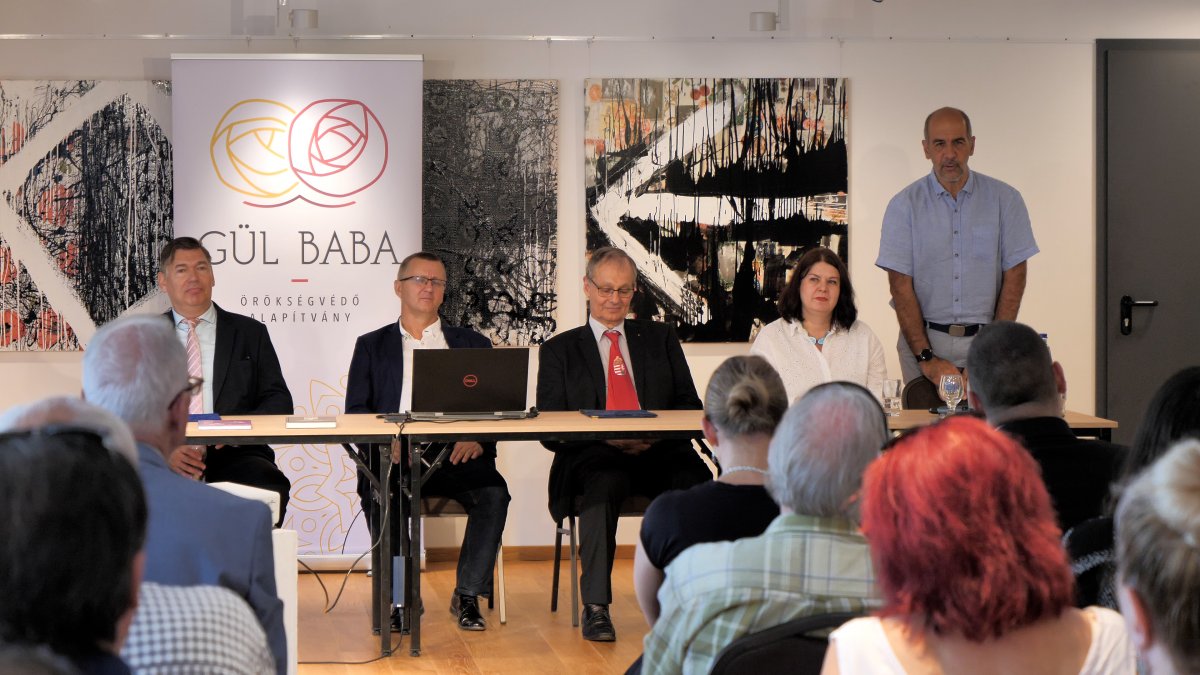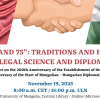Rare gold coin and future visitor centre in Turbék
2024
Jul
02
We stand with our feet in the ground in the middle of the archaeological site, the silence broken only by birdsong, surrounded by small piles of dirt, small markers and carefully spread archaeological tools everywhere. Two researchers bend down to carefully clean an old stone remnant with a brush. This is none other than the site of the excavation of the former mausoleum of Sultan Suleiman I at Turbek. On the basis of a contract signed between the Szentágothai János Research Centre of the University of Pécs and the Turbe of Gül Baba Heritage Foundation, researchers set out once again to uncover the secrets of the site in Turbékpuszta, which they announced at a press conference and field visit in Szigetvár on 28 June.

The research was started in 2013 under the leadership of Dr. Norbert Pap, and by 2015 the first significant result was achieved: the turbe of the Ottoman Sultan Suleiman I, who died in 1566 during the siege of Szigetvár, was discovered. Since the beginning of the research, the research team from Pécs, supported by the Turkish state agency TIKA, has been working hard to uncover the turret built on the vineyard. The discovery is of not only historical but also of cultural significance, as it has brought a piece of the past back to the present, giving us the opportunity to better understand the shared history of the Ottoman Empire and Hungary.

The search can be compared to a giant jigsaw puzzle, where every find, every tiny piece contributes to the big picture. The painstaking work of the researchers reveals the details that make the past accessible to the present.The results published in recent years have given us a deeper insight into the world of medieval Ottoman architecture and culture.
The new research phase aims to systematically scan around 50% of the area. This will not only contribute to scientific knowledge, but will also pave the way for the planning of a museum facility to be established at a later date. "In the year 2024, a systematic survey of the site will be carried out in order to determine how the heritage values can be properly explored and the infrastructure needed to present them can be placed on the site," explains Dr. Norbert Pap, professor at the Institute of Geography and Earth Sciences and the Szentágothai János Research Centre of the University of Pécs.

The finds from the sections excavated so far already enrich the historical significance of the area. The most remarkable find was an extremely rare gold coin from Genoa, but it bears a Venetian pattern. The coin is special not only because there are less than ten of them in the world, but also because it is historically significant.
"It is rare because in the middle of the 16th century coins of this type were minted only for a short period. When the Venetians noticed that the Genoese were making gold coins just like theirs, they immediately protested. Because of this, there are only a few of them in the world and their value is quite high,"
said Dr. Máté Kitanics, research fellow at the Szentágothai János Research Centre of PTE Szentágothai. The gold coin weighs 3.5 grams and is about 20 mm in diameter.

Research is not only the work of archaeologists, but also a community effort. Students of archaeology at the University of Pécs and students of the Institute of Geography and Earth Sciences participate in the excavation every year, and their enthusiasm and work contribute greatly to its success. "In addition to Hungarian archaeology and geography students, Turkish students also participate in the research, and this year we were joined by students from South Africa, the United States, China, Japan and Uruguay", said Dr. Erika Hancz, Head of Excavation, Archeologist and Assistant Research Fellow at the Department of Archaeology at UP. This international cooperation not only raises the quality of research, but also contributes to building cultural and scientific relations. The excavation manager added that
anyone who would like to join the excavation should contact them by e-mail, as they are even willing to recruit volunteers.

The archaeological project of the University of Pécs is not only important from a scientific point of view, but also for the community. A visitor centre is planned to be built where the public will be able to learn about the finds and the history of the area. Interactive exhibitions, educational programmes and guided tours will allow people interested in archaeology to experience first-hand the relics of the past. "From a tourist point of view, Szigetvár will not just be a destination for 2-3 days, but a place where tourists will want to spend a week," added Péter Vass, Mayor of Szigetvár.

With the planned visitor centre, the excavation at Turbék will provide a unique insight into a significant period of the Ottoman era. The results achieved and the new excavations will provide an opportunity for those interested in history to better understand and appreciate the rich heritage of the past. The new research and the implementation of the visitor centre will not only increase interest in archaeology, but will also contribute to the cultural enrichment of the local community.

As more and more layers are uncovered, archaeologists are getting closer to understanding the past with each find. In their work, they bring to life not only historical facts but also human stories that help us better understand the world of our ancestors. Through the archaeological excavations and the planned visitor centre, the excavation in Turbék offers a unique opportunity for the general public to be part of this fascinating journey into the past.
Written by Mercédesz Kovács-Csincsák
- Log in to post comments
University of Pécs | Chancellery | IT Directorate | Portal group - 2020.






















